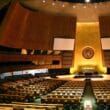The unlearned lessons of 1945
By Suvrat Raju |
In May 1945, a committee of military officers, physicists, and mathematicians—including well-known figures such as Robert Oppenheimer, John von Neumann, and Norman Ramsey—met to discuss possible targets in Japan for the Bomb. The committee's records reveal the motivations and attitudes of these influential advisors. They recommended that the "initial use [be] sufficiently spectacular for the importance of the weapon to be internationally recognized when publicity on it is released" and rated Kyoto as an "AA target" because it had "the advantage of the people being more highly intelligent and hence better able to appreciate the significance of the weapon." Kyoto was eventually spared by the Truman administration, which settled instead on Hiroshima. The "advantage" of that city, also rated "AA," was that "possible focusing from nearby mountains" could cause "a large fraction of the city [to] be destroyed."
After the United States dropped the Bomb on Hiroshima, it distributed a leaflet explaining to the Japanese that Washington possessed "the most destructive explosive ever devised by man. … This awful fact is one for you to ponder." Simultaneously, the White House released a triumphant statement declaring that it was "now prepared to obliterate more rapidly and completely every productive enterprise the Japanese have above ground in any city."
These records demonstrate that the bombings of Hiroshima and Nagasaki were designed and executed as acts of terror. Nationalist US historians have argued that the bombings were preferable to a US invasion—but this is a debate into which no counterfactuals need be introduced. A simple factual question is sufficient for rendering ethical judgment: Did the US government make earnest efforts to save both Japanese and American lives?
The historical record is conclusive that it did not. Putting aside the Potsdam Declaration—whose demand for unconditional surrender appears to have been phrased to invite rejection and provide a justification for dropping the Bomb—the Truman administration refused to consider alternatives to the use of the Bomb on a populated area. The prescient Franck Committee, in a memorandum communicated to the secretary of war in June 1945, recommended the "demonstration of the new weapon … on the desert or a barren island." This idea was promptly rejected by the secretary's scientific advisory panel, whose members saw "no acceptable alternative to direct military use."
This history is important because it is emblematic of the disregard with which policy makers in Washington treat human life in pursuit of strategic objectives. If Americans had better understood this characteristic of their government at the end of the war they might have demonstrated greater opposition to subsequent US interventions in other countries. But after the war, nationalist apologists were successful in obscuring the lessons of Hiroshima and Nagasaki. This partly explains why domestic opposition to US aggression against Southeast Asia—which started just a few years after World War II and eventually led to millions of deaths there—was muted for so long. Today, the US military still projects the Bomb in a positive light. The "shock and awe" campaign at the start of the Iraq War in 2003 was inspired by a doctrine that sought to "achieve a level of national shock akin to the effect that dropping nuclear weapons on Hiroshima and Nagasaki had on the Japanese."
Justifications for bombing Hiroshima and Nagasaki are ultimately based on the idea that yardsticks applicable to most nations are inapplicable to the US government and its allies. The same presumption has often undermined international arms control efforts. The mainstream Western discourse on Iran holds that it would be undesirable for Tehran to acquire a nuclear bomb—but simply ignores the fact that US or Israeli possession of nuclear arsenals is equally problematic.
This is not just an ethical issue—it is also a practical problem for disarmament. The United States, going back to farcical attempts by Gen. Leslie Groves to buy up the world's uranium supply during World War II, has waged but slowly lost a battle to possess nuclear weapons while controlling their spread to other nations. In the seven decades since Hiroshima and Nagasaki, eight nations have acquired nuclear weapons. Given the inherent instability of a configuration of multiple nuclear powers, the only way to ensure that the world does not see another nuclear explosion in the next seven decades is to recognize that nonproliferation is simply unsustainable without universal disarmament.
A just order. Just as politics has failed to incorporate the lessons of the bombings, the scientific community has failed to introspect meaningfully on its role in developing nuclear weapons. Even members of the "target committee" escaped opprobrium in academia. Richard Feynman's memoir exemplifies the manner in which the scientific community rationalized its collaboration with the military: "von Neumann gave me an interesting idea: that you don't have to be responsible for the world that you're in. So I have developed a very powerful sense of social irresponsibility."
Scientists, assuaging their consciences in this manner, willingly accepted the postwar embrace of the US defense establishment. As science historian Paul Forman explains, "Faced with big bucks, neither political persuasion nor anti-political disposition were strong enough to hold the physicists."
This arrangement cedes power to the defense industry over directions of research. But it also limits the space available for dissent in academic institutions. For instance, a US law known as the Solomon Amendment can be used to deny federal research funding to any university that denies access to military recruiters, or bans the Reserve Officers' Training Corps.
The situation is similar in India, where the Department of Atomic Energy funds research in both mathematics and theoretical physics. In 1962, the eminent mathematician D. D. Kosambi was removed from the Tata Institute of Fundamental Research—ostensibly for publishing an incorrect proof of the Riemann hypothesis, but more plausibly for his public opposition to nuclear weapons and energy. Decades later, the department instructed the Institute of Mathematical Sciences to take action against members of its faculty who had written in opposition to India's 1998 nuclear tests. Similar incidents have occurred more recently—though, by their nature, they are difficult to document comprehensively.
In the nuclear era, the survival of humanity is closely tied to the abolition of war; this much has long been clear. But lasting peace is possible only in a just international order—where aggression by powerful countries isn't tolerated, international relations are guided by equality instead of by exceptionalism, and science is guided by social rather than military objectives. On the 70th anniversary of the bombings of Hiroshima and Nagasaki, it is time for the world to acknowledge and act on these lessons.














